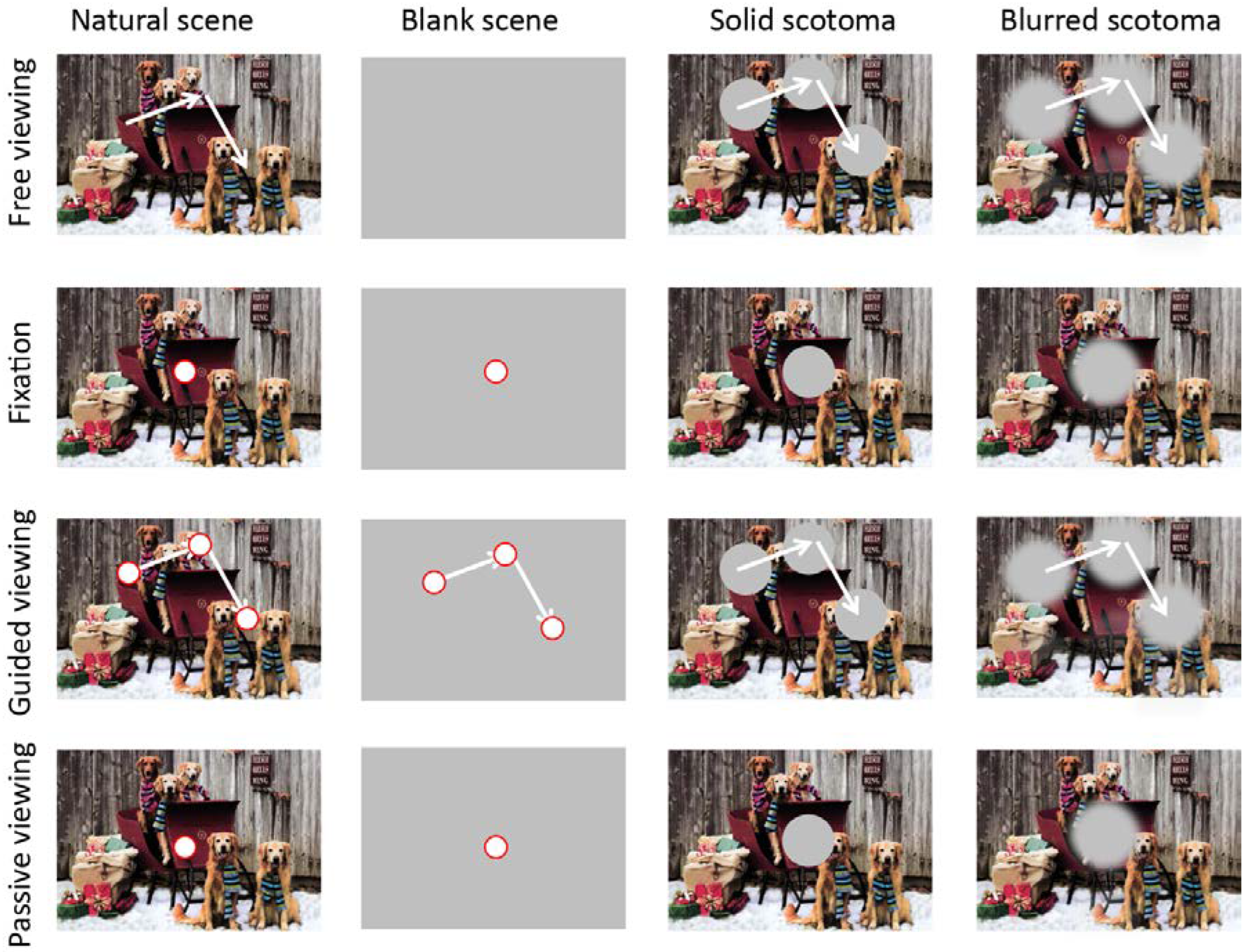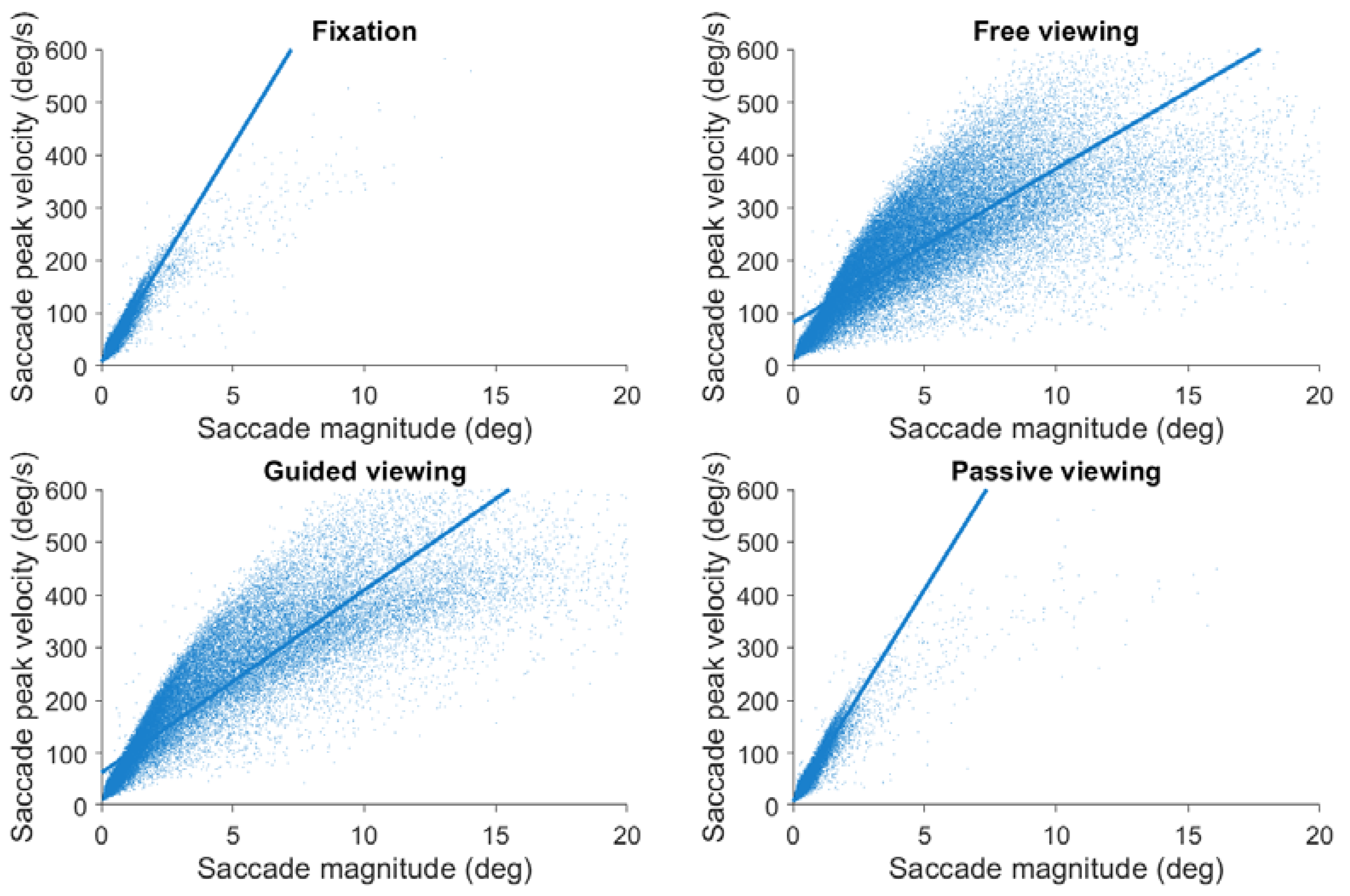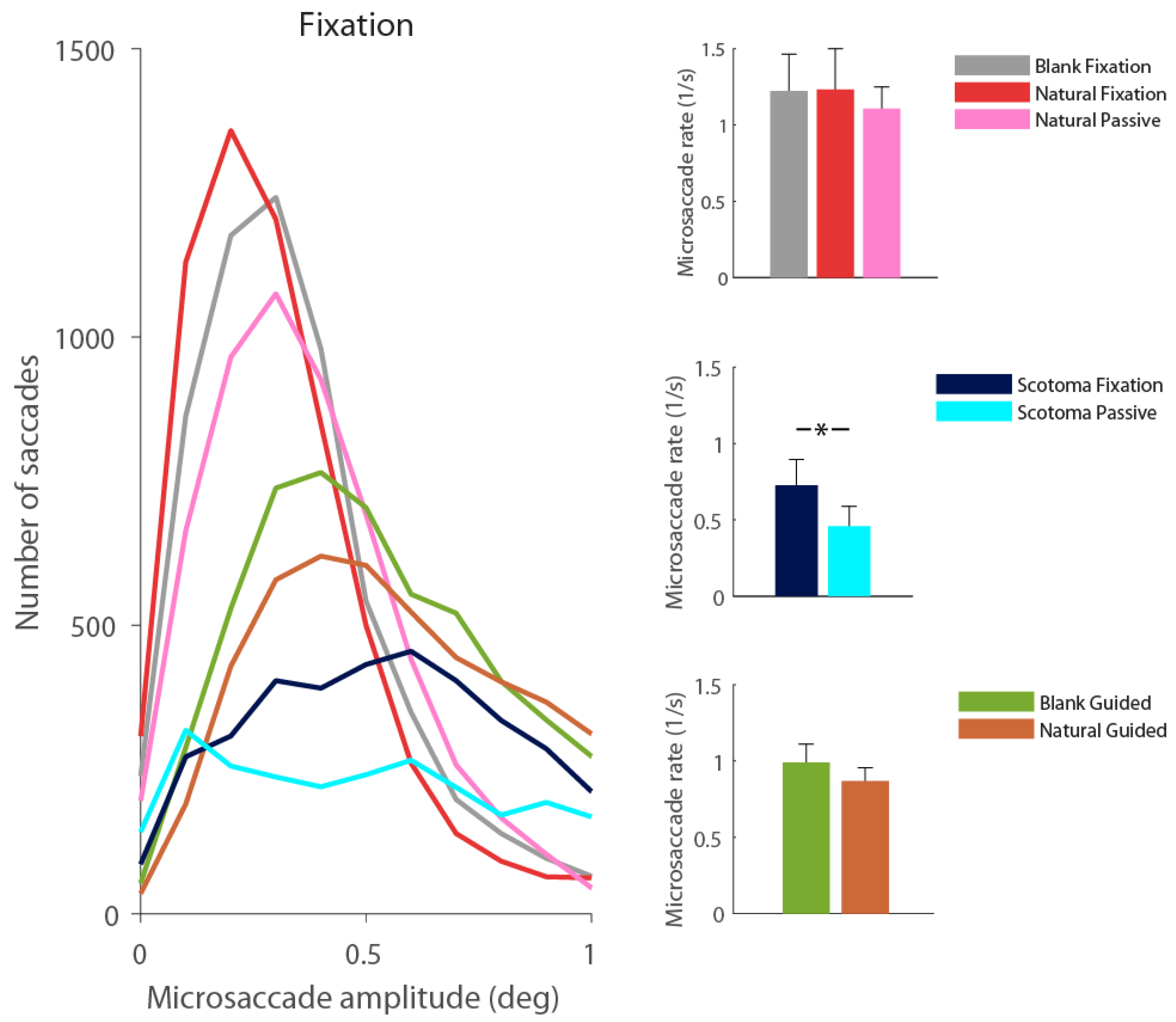Microsaccade Generation Requires a Foveal Anchor
Abstract
Introduction
Methods
Participants
Experimental Design
Eye Movement Analyses
Statistical Methods
Results
Effects of present versus absent foveal stimulation on microsaccades
Effects of dynamic versus static peripheral stimulation on microsaccades
Discussion
Effects of simulated visual loss on exploratory eye movements
Effects of varying foveal visual stimulation on microsaccades
Effects of ophthalmic loss on microsaccades
Link between peripheral visual stimulation and microsaccade production
Conclusions
Acknowledgments
Conflicts of Interest
References
- Aguilar, C., and E. Castet. 2011. Gaze-contingent simulation of retinopathy: Some potential pitfalls and remedies. Vision Research 51, 9: 997–1012. [Google Scholar] [CrossRef] [PubMed]
- Bahill, A. T., M. R. Clark, and L. Stark. 1975. The main sequence, a tool for studying human eye movements. Mathematical Biosciences 24, 3: 191–204. [Google Scholar] [CrossRef]
- Bellet, M. E., J. Bellet, H. Nienborg, Z. M. Hafed, and P. Berens. 2018. Human-level saccade detection performance using deep neural networks. [Google Scholar] [CrossRef]
- Chung, S. T. L., G. Kumar, R. W. Li, and D. M. Levi. 2015. Characteristics of fixational eye movements in amblyopia: Limitations on fixation stability and acuity? Vision Research 114: 87–99. [Google Scholar] [CrossRef] [PubMed]
- Costela, F. M., J. Otero-Millan, M. B. McCamy, S. L. Macknik, X. G. Troncoso, A. N. Jazi, and S. Martinez-Conde. 2014. Fixational eye movement correction of blink-induced gaze position errors. PLoS ONE 9: e110889. [Google Scholar]
- David, E. J., P. Le Callet, M. P. Da Silva, and P. Lebranchu. 2018. How are ocular behaviours affected by central and peripheral vision loss? A study based on artificial scotomas and gaze-contingent paradigm. [Text]. January 28, Available online: https://www.ingentaconnect.com/conten-tone/ist/ei/2018/00002018/00000014/art00005#.
- David, E. J., P. Lebranchu, M. Perreira Da Silva, and P. Le Callet. 2019. Predicting artificial visual field losses: A gaze-based inference study. Journal of Vision 19, 14: 22. [Google Scholar] [CrossRef]
- Di Stasi, L. L., M. B. McCamy, A. Catena, S. L. Macknik, J. J. Cañas, and S. Martinez-Conde. 2013. Microsaccade and drift dynamics reflect mental fatigue. European Journal of Neuroscience 38, 3: 2389–2398. [Google Scholar] [CrossRef]
- Di Stasi, L. L., M. B. McCamy, S. Pannasch, R. Renner, A. Catena, J. J. Cañas, B. M. Velichkovsky, and S. Martinez-Conde. 2015. Effects of driving time on microsaccadic dynamics. Experimental Brain Research 233, 2: 1–7. [Google Scholar] [CrossRef]
- Ditchburn, R. W., and B. L. Ginsborg. 1953. Involuntary eye movements during fixation. The Journal of Physiology 119, 1: 1–17. [Google Scholar]
- Duchowski, A. T., N. Cournia, and H. Murphy. 2004. Gaze-Contingent Displays: A Review. CyberPsychology & Behavior 7, 6: 621–634. [Google Scholar] [CrossRef]
- Engbert, R. 2006. Microsaccades: A microcosm for research on oculomotor control, attention, and visual perception. In Progress in Brain Research. Elsevier: Vol. 154, pp. 177–192. Available online: http://linkinghub.elsevier.com/retrieve/pii/S0079612306540099.
- Engbert, R., and R. Kliegl. 2003. Microsaccades uncover the orientation of covert attention. Vision Research 43, 9: 1035–1045. [Google Scholar] [CrossRef]
- Engbert, R., and K. Mergenthaler. 2006. Microsaccades are triggered by low retinal image slip. Proceedings of the National Academy of Sciences 103, 18: 7192–7197. [Google Scholar] [CrossRef] [PubMed]
- Glen, F. C., N. D. Smith, L. Jones, and D. P. Crabb. 2016. ‘I didn’t see that coming’: Simulated visual fields and driving hazard perception test performance. Clinical and Experimental Optometry 99, 5: 469–475. [Google Scholar] [CrossRef] [PubMed]
- Hafed, Z. M., and A. Ignashchenkova. 2013. On the Dissociation between Microsaccade Rate and Direction after Peripheral Cues: Microsaccadic Inhibition Revisited. Journal of Neuroscience 33, 41: 16220–16235. [Google Scholar] [CrossRef] [PubMed]
- Kleiner, M., D. Brainard, D. Pelli, A. Ingling, R. Murray, and C. Broussard. 2007. What’s new in psychtoolbox-3. Perception 36, 14: 1–16. [Google Scholar]
- Ko, H., M. Poletti, and M. Rucci. 2010. Microsaccades precisely relocate gaze in a high visual acuity task. Nat Neurosci 13, 12: 1549–1553. [Google Scholar] [CrossRef]
- Kumar, G., and S. T. L. Chung. 2014. Characteristics of Fixational Eye Movements in People With Macular Disease. Investigative Ophthalmology & Visual Science 55, 8: 5125–5133. [Google Scholar] [CrossRef]
- Kwon, M., A. S. Nandy, and B. S. Tjan. 2013. Rapid and Persistent Adaptability of Human Oculomotor Control in Response to Simulated Central Vision Loss. Current Biology 23, 17: 1663–1669. [Google Scholar] [CrossRef]
- Laubrock, J., A. Cajar, and R. Engbert. 2013. Control of fixation duration during scene viewing by interaction of foveal and peripheral processing. Journal of Vision 13, 12: 11. [Google Scholar] [CrossRef]
- Laubrock, J., R. Engbert, and R. Kliegl. 2005. Microsaccade dynamics during covert attention. Vision Research 45, 6: 721–730. [Google Scholar] [CrossRef]
- Martinez-Conde, S., and S. L. Macknik. 2017. Unchanging visions: The effects and limitations of ocular stillness. Philosophical Transactions of the Royal Society B: Biological Sciences 372, 1718: 20160204. [Google Scholar] [CrossRef]
- Martinez-Conde, S., S. L. Macknik, and D. H. Hubel. 2004. The role of fixational eye movements in visual perception. Nature Reviews Neuroscience 5, 3: 229–240. [Google Scholar] [CrossRef] [PubMed]
- Martinez-Conde, S., S. L. Macknik, X. G. Troncoso, and D. H. Hubel. 2009. Microsaccades: A neurophysiological analysis. Trends in Neurosciences 32, 9: 463–475. [Google Scholar] [CrossRef] [PubMed]
- Martinez-Conde, S., J. Otero-Millan, and S. L. Macknik. 2013. The impact of microsaccades on vision: Towards a unified theory of saccadic function. Nature Reviews Neuroscience 14, 2: 83–96. [Google Scholar] [CrossRef] [PubMed]
- McCamy, M. B., A. Najafian Jazi, J. Otero-Millan, S. L. Macknik, and S. Martinez-Conde. 2013a. The effects of fixation target size and luminance on microsaccades and square-wave jerks. PeerJ 1: e9. [Google Scholar] [CrossRef]
- McCamy, M. B., A. Najafian Jazi, J. Otero-Millan, S. L. Macknik, and S. Martinez-Conde. 2013b. The effects of fixation target size and luminance on microsaccades and square-wave jerks. PeerJ 1: e9. [Google Scholar] [CrossRef]
- McCamy, M. B., J. Otero-Millan, L. L. Di Stasi, S. L. Macknik, and S. Martinez-Conde. 2014. Highly informative natural scene regions increase microsaccade production during visual scanning. The Journal of Neuroscience 34, 8: 2956–2966. [Google Scholar] [CrossRef]
- McIlreavy, L., J. Fiser, and P. J. Bex. 2012. Impact of Simulated Central Scotomas on Visual Search in Natural Scenes. Optometry and Vision Science 89, 9: 1385. [Google Scholar] [CrossRef]
- Mihali, A., B. van Opheusden, and W. J. Ma. 2017. Bayesian microsaccade detection. Journal of Vision 17, 1: 13. [Google Scholar] [CrossRef]
- Olmos, A., and F. A. A. Kingdom. 2004. A biologically inspired algorithm for the recovery of shading and reflectance images. Perception 33, 12: 1463–1473. [Google Scholar] [CrossRef]
- Otero-Millan, J., J. L. A. Castro, S. L. Macknik, and S. Martinez-Conde. 2014. Unsupervised clustering method to detect microsaccades. Journal of Vision 14, 2: 18. [Google Scholar] [CrossRef]
- Otero-Millan, J., A. Serra, R. J. Leigh, X. G. Troncoso, S. L. Macknik, and S. Martinez-Conde. 2011. Distinctive Features of Saccadic Intrusions and Microsaccades in Progressive Supranuclear Palsy. Journal of Neuroscience 31, 12: 4379–4387. [Google Scholar] [CrossRef] [PubMed]
- Otero-Millan, Jorge, S. L. Macknik, R. E. Langston, and S. Martinez-Conde. 2013. An oculomotor continuum from exploration to fixation. Proceedings of the National Academy of Sciences 110, 15: 6175–6180. [Google Scholar] [CrossRef]
- Otero-Millan, Jorge, X. G. Troncoso, S. L. Macknik, I. Serrano-Pedraza, and S. Martinez-Conde. 2008. Saccades and microsaccades during visual fixation, exploration and search: Foundations for a common saccadic generator. Journal of Vision 8: 14–21. [Google Scholar] [CrossRef]
- Paulun, V. C., A. C. Schütz, M. M. Michel, W. S. Geisler, and K. R. Gegenfurtner. 2015. Visual search under scotopic lighting conditions. Vision Research 113: 155–168. [Google Scholar] [CrossRef][Green Version]
- Raveendran, R. N., W. Bobier, and B. Thompson. 2019. Reduced amblyopic eye fixation stability cannot be simulated using retinal-defocus-induced reductions in visual acuity. Vision Research 154: 14–20. [Google Scholar] [CrossRef]
- Reingold, E. M., and L. C. Loschky. 2002. Saliency of peripheral targets in gaze-contingent multiresolutional displays. Behavior Research Methods, Instruments, & Computers 34, 4: 491–499. [Google Scholar] [CrossRef]
- Rolfs, M. 2009. Microsaccades: Small steps on a long way. Vision Research 49, 20: 2415–2441. [Google Scholar] [CrossRef]
- Rolfs, M., R. Kliegl, and R. Engbert. 2008. Toward a model of microsaccade generation: The case of microsaccadic inhibition. Journal of Vision 8, 11: 1–23. [Google Scholar] [CrossRef]
- Rolfs, M., J. Laubrock, and R. Kliegl. 2006. Shortening and prolongation of saccade latencies following microsaccades. Experimental Brain Research 169, 3: 369–376. [Google Scholar] [CrossRef]
- Shaikh, A. G., J. Otero-Millan, P. Kumar, and F. F. Ghasia. 2016. Abnormal Fixational Eye Movements in Amblyopia. PLOS ONE 11, 3: e0149953. [Google Scholar] [CrossRef]
- Shi, X. F., L. Xu, Y. Li, T. Wang, K. Zhao, and B. A. Sabel. 2012. Fixational saccadic eye movements are altered in anisometropic amblyopia. Restorative Neurology and Neuroscience 30, 6: 445–462. [Google Scholar] [PubMed]
- Siegenthaler, E., F. M. Costela, M. B. McCamy, L. L. Di Stasi, J. Otero-Millan, A. Sonderegger, R. Groner, S. Macknik, and S. Martinez-Conde. 2014. Task difficulty in mental arithmetic affects microsaccadic rates and magnitudes. European Journal of Neuroscience 39, 2: 287–294. [Google Scholar] [CrossRef] [PubMed]
- Steinman, R. M. 1965. Effect of Target Size, Luminance, and Color on Monocular Fixation. Journal of the Optical Society of America 55, 9: 1158–1164. [Google Scholar] [CrossRef]
- Subramanian, V., R. M. Jost, and E. E. Birch. 2013. A quantitative study of fixation stability in amblyopia. Investigative Ophthalmology & Visual Science 54, 3: 1998–2003. [Google Scholar] [CrossRef]
- Thaler, L., A. C. Schütz, M. A. Goodale, and K. R. Gegenfurtner. 2013. What is the best fixation target? The effect of target shape on stability of fixational eye movements. Vision Research 76: 31–42. [Google Scholar] [CrossRef]






  |
Copyright © 2020. This article is licensed under a Creative Commons Attribution 4.0 International License.
Share and Cite
Otero-Millan, J.; Langston, R.E.; Costela, F.; Macknik, S.L.; Martinez-Conde, S. Microsaccade Generation Requires a Foveal Anchor. J. Eye Mov. Res. 2019, 12, 1-14. https://doi.org/10.16910/jemr.12.6.14
Otero-Millan J, Langston RE, Costela F, Macknik SL, Martinez-Conde S. Microsaccade Generation Requires a Foveal Anchor. Journal of Eye Movement Research. 2019; 12(6):1-14. https://doi.org/10.16910/jemr.12.6.14
Chicago/Turabian StyleOtero-Millan, Jorge, Rachel E. Langston, Francisco Costela, Stephen L. Macknik, and Susana Martinez-Conde. 2019. "Microsaccade Generation Requires a Foveal Anchor" Journal of Eye Movement Research 12, no. 6: 1-14. https://doi.org/10.16910/jemr.12.6.14
APA StyleOtero-Millan, J., Langston, R. E., Costela, F., Macknik, S. L., & Martinez-Conde, S. (2019). Microsaccade Generation Requires a Foveal Anchor. Journal of Eye Movement Research, 12(6), 1-14. https://doi.org/10.16910/jemr.12.6.14



